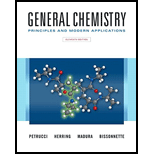
Concept explainers
Interpretation:
The three properties which are expected for
Concept introduction:
Transition metals are those metals which are present from group 3 to 11 in the periodic table. They are known as d-block elements and contain partially filled d-orbitals. The second and third row elements in the periodic table show change in properties on moving from left to right. Due to little shielding effect on the outer electrons, there is increase in effective nuclear charge results if a proton is added to the nucleus. This result in smaller atomic radius, increased ionization energy, increased electronegativity and increased non-metallic character of the transition elements.
Some of the properties of the transition elements are as follows:
- They have large charge to radius ratio.
- The density of transition elements is high and they are also hard in nature.
- The melting and boiling points of the transition elements are high.
- They form paramagnetic compounds.
- There is variable oxidation state shown by the transition elements.
- They form colored compounds.
- The compounds form by transition metals has catalytic activity.
- They form stable complexes.
Want to see the full answer?
Check out a sample textbook solution
Chapter 23 Solutions
Generl Chem Looself&mod Mst/et&stdy Crd Pkg, 11/e
- (a) What is the lanthanide contraction? (b) How does it affectatomic size down a group of transition elements? (c) How doesit influence the densities of the Period 6 transition elements?arrow_forward(a) How would you account for the following: (i) Highest fluoride of Mn is MnF4 whereas the highest oxide is Mn2O2 (ii) Transition metals and their compounds show catalytic properties.arrow_forwardPlease do short explaination the Lanthanide Contraction phenomena along with the example.arrow_forward
- Divide the electron configurations d1 through d10 among the groupmembers such that every configuration is assigned to at least twogroup members. Working individually, draw the orbital diagram forthe configurations assigned to you, including both high-spin andlow-spin diagrams where possible. Present your diagrams to yourgroup. Combine all diagrams into one set for the group.arrow_forwardDescribe how magnetism in lanthanides series arisesarrow_forwardAmong the (pi) acid ligands of groups 15 and 16, which is the most similar, regarding the capacity ofretro-donation, to the CO? Why?arrow_forward
- Investingate and report the uses of ferromagnetic oxides in magnetic recording tapesarrow_forwardThe standard reduction potential for the reaction [Co( H 2 O)6]3+(aq)+e[CO( H 2 O)6]2+(aq) is about 1.8 V. The reduction potential for the reaction [Co( NH 3 )6]3+(aq)+e[Co( NH 3 )6]2+(aq) is +0.1 V. Calculate the cell potentials to show whether the complex ions,. [Co( H 2 O)6]2+ and or [Co( NH 3 )6]2+, can be oxidized to the corresponding Cobalt (III) complex by oxygen.arrow_forwardA 3.03-g petroleum specimen was decomposed by wet ashing and subsequently diluted to 500 mL in a volumetric flask. Cobalt was determined by treating 25.00-mL aliquots of this diluted solution as follows: Assume that the Co(II)-ligand chelate obeys Beer’s law, and calculate the percentage of cobalt in the original sample.arrow_forward
- Why are multidentate ligands preferable to unidentate ligands for complexometric titrations? Explain.arrow_forwardConsidering the bonding properties of the basic oxide reacting with the acid and the acid oxide reacting with the base, predict what binding properties the amphoteric oxide has.Predict how Mn or Cr differs from an oxide with an oxidation number of 5 or more and an oxide with an oxidation number of 3 or less.Amphotism: Properties that react with both acids and basesarrow_forwardDinitrogen is very unreactive, but it can form complexes with transition metals. Explain why and how. Give an example.arrow_forward
 Chemistry: Principles and PracticeChemistryISBN:9780534420123Author:Daniel L. Reger, Scott R. Goode, David W. Ball, Edward MercerPublisher:Cengage Learning
Chemistry: Principles and PracticeChemistryISBN:9780534420123Author:Daniel L. Reger, Scott R. Goode, David W. Ball, Edward MercerPublisher:Cengage Learning Chemical Principles in the LaboratoryChemistryISBN:9781305264434Author:Emil Slowinski, Wayne C. Wolsey, Robert RossiPublisher:Brooks Cole
Chemical Principles in the LaboratoryChemistryISBN:9781305264434Author:Emil Slowinski, Wayne C. Wolsey, Robert RossiPublisher:Brooks Cole Chemistry by OpenStax (2015-05-04)ChemistryISBN:9781938168390Author:Klaus Theopold, Richard H Langley, Paul Flowers, William R. Robinson, Mark BlaserPublisher:OpenStax
Chemistry by OpenStax (2015-05-04)ChemistryISBN:9781938168390Author:Klaus Theopold, Richard H Langley, Paul Flowers, William R. Robinson, Mark BlaserPublisher:OpenStax Chemistry & Chemical ReactivityChemistryISBN:9781337399074Author:John C. Kotz, Paul M. Treichel, John Townsend, David TreichelPublisher:Cengage Learning
Chemistry & Chemical ReactivityChemistryISBN:9781337399074Author:John C. Kotz, Paul M. Treichel, John Townsend, David TreichelPublisher:Cengage Learning Chemistry: The Molecular ScienceChemistryISBN:9781285199047Author:John W. Moore, Conrad L. StanitskiPublisher:Cengage Learning
Chemistry: The Molecular ScienceChemistryISBN:9781285199047Author:John W. Moore, Conrad L. StanitskiPublisher:Cengage Learning





